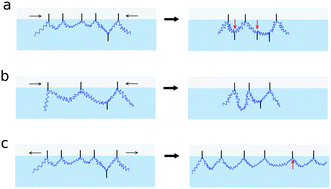Probing the adsorption/desorption of amphiphilic polymers at the air–water interface during large interfacial deformations
Abstract
Hydrophobically modified polymers are good candidates for the stabilization of liquid interfaces thanks to the high anchoring energy of the hydrophobic parts. In this article we probe the interfacial anchoring of a series of home-made hydrophobically modified polymers with controlled degree of grafting by studying their behavior upon large area dilations and compressions. By comparing the measured interfacial tension to the one that we expect in the case of a constant number of adsorbed monomers, we are able to deduce whether desorption or adsorption occurs during area variations. We find that the polymer chains with the longest hydrophobic grafts desorb at larger compressions compared to the polymers with the shortest grafts, because of their larger desorption energy. Furthermore, for a given graft length, we observe more desorption for polymers with the highest grafting densities. We attribute this counter intuitive result to the fact that at high grafting densities, the length of the polymer loops is shorter, and hence the elastic penalty upon compression is larger for these layers, leading to a faster desorption. Comparing the elastic penalty to thermal energy, kBT, enables deducing a critical grafting density above which desorption of grafts is expected upon compression, which is consistent with our experimental results. In the case of large area dilations, the experiments reveal that the number of adsorbed anchors remains constant in the case of chains with a low grafting density while chains with the highest degree of grafting seem to show some degree of adsorption during the dilatation. Therefore, in these highly grafted chains there may be unadsorbed grafts remaining in the vicinity of the interface, which may adsorb quickly at the interface upon dilatation.



 Please wait while we load your content...
Please wait while we load your content...